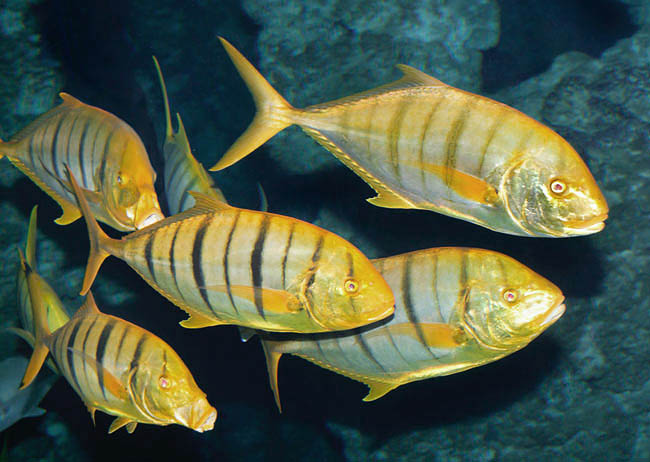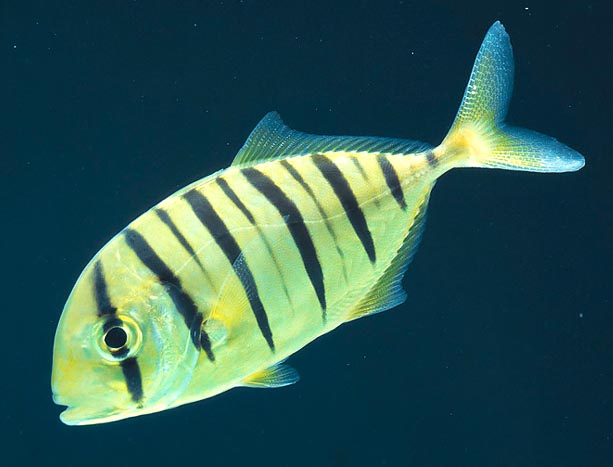Family : Carangidae

Text © Giuseppe Mazza

English translation by Mario Beltramini

Gnathodon speciosus adults may reach the 120 cm and the 15 kg © Giuseppe Mazza
The name of the genus comes from the Greek “gnathos” = jaw, and “a” = privative, without and “odus” = tooth, therefore, with jaws having no teeth, due to the rubbery and fleshy lips.
The name of the species “speciosus” means beautiful in Latin, undoubtedly deserved attribute in a family which does not abound in colours like that of the carangids.
Zoogeography
It has a vast diffusion in the tropical waters of the Indian and Pacific oceans. We find it, indicatively, along the whole African coast, from South Africa and Madagascar up to the Red Sea and the Arabian Sea, to the Seychelles Islands, Mauritius, Réunion, Maldives, in India, Sri Lanka, Christmas Island, Thailand, Malaysia, Australia, Indonesia, Micronesia, New Guinea, New Caledonia, Philippines, Taiwan and China up to southern Japan. Eastwards, it reaches California, Mexico and Ecuador.
Ecology-Habitat
Even if it looks for small preys into the sand, it is a mainly pelagic species moving on the outer side of the reefs reaching, at most, the depth of 50 metres. The juveniles, insensitive to the poison, often find shelter among the tentacles of the jellyfishes or stay beside, like the Pilot fishes (Naucrates ductor Linneo, 1758) which, in any case, belong to the same family, the sharks, cleaning them from the parasites and from the food scraps. In both cases, this is a sure deterrent against the predators.

Young have more marked vertical bands and feed the aquaria market © Giuseppe Mazza
The golden trevally can reach the 120 cm and the weight of 15 kg. The body is laterally compressed, fusiform, with the dorsal fin in a rear position showing 8 spiny rays and 18-20 soft. The anal fin, shorter and symmetric, has 3 spiny rays and 15-17 unarmed; the pectoral are falciform and strong, the ventral ones are modest and the forked caudal is bilobed in the juveniles. These last have yellow livery crossed by 6 great vertical black stripes, the first one being at the level of the eye, alternated by some thinner ones with a clear mimetic function. In the adults the colour tones get more silvery, but the golden reflections often persist.
Ethology-Reproductive Biology
It lives in small schools nourishing of molluscs, crustaceans and modest sized fishes it absorbs with its protractile mouth. It often hunts in group, surrounding the schools of young herrings and mackerels.
The reproduction takes place during the night, collectively, with the eggs abandoned to the currents.
In Asia, it is often fished for alimentary purposes and there are people breeding it for the flesh, as we do for the sea breams and basses. The juveniles, thanks to their bright livery and the low cost, do feed the aquaria market.
Even if it is a species with a diversified diet, which, submitted to stress, may double its number in 1,4-4,4 years, due to the fishing it has nowadays a moderate vulnerability index, of 38 on a scale of 100, that might increase.
Synonyms
Caranx cives De Vis, 1884; Caranx edentulus Alleyne & Macleay, 1877; Caranx panamensis Gill, 1863; Caranx speciosus Forsskål, 1775; Scomber speciosus Forsskål, 1775.
→ For general information about FISH please click here.
→ For general information about BONY FISH please click here
→ For general information about CARTILAGINOUS FISH please click here.
→ To appreciate the BIODIVERSITY of BONY FISH please click here.
→ To appreciate the BIODIVERSITY of CARTILAGINOUS FISH please click here.
